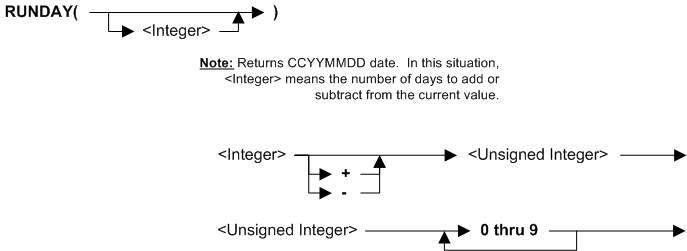Function RUNDAY
TABLE OF CONTENTS
- What is RUNDAY?
- How do I use RUNDAY?
- Syntax
- Rules for the syntax
- Examples: RUNDAY function in ERF
- Examples: RUNDAY function in ECL
What is RUNDAY?
The RUNDAY function is dependent on the run date, or execution date of the GenevaERS extract job. The default run date is the date when the extract job is run. You can override the run date with the extract job parameter RUN_DATE, to make the job appear to run on a different date.
All views in the extract job batch use the same run date.
RUNDAY returns a CCYYMMDD format date based on the run date, plus or minus the number of days specified in the parameter.
This date can be used for setting column values, for comparisons, and evaluating lookup “effective dates”.
How do I use RUNDAY?
The parameter for RUNDAY is a number of days to add or subtract from the default RUNDAY. For example, RUNDAY(-5) provides the date five days before the date the view is run.
RUNDAY can only be used in Extract-Phase Logic.

Syntax

Rules for the syntax
The parameter for RUNDAY is a number of days to add or subtract from the default RUNDAY. For example, RUNDAY(-5) provides the day five days before the date the view is run.
RUNDAY can only be used in Extract Record Filter (ERF) and Extract Column Logic (ECL) text.
See also topic: Rules for all Logic Text
Examples: RUNDAY function in ERF
| Example logic text | Meaning |
|---|---|
| IF ({field1} < RUNDAY(-7)) THEN SKIP ENDIF |
Skip any input records where field1 is more than 7 days before the date of running this view, and select all other records. This example assumes that field1 is a date. The code at left can also be written as: SKIPIF({field1} < RUNDAY(-7)) |
Examples: RUNDAY function in ECL
| Example logic text | Meaning |
|---|---|
| COLUMN = RUNDAY() | Set current column to the same day number as the view is run. |